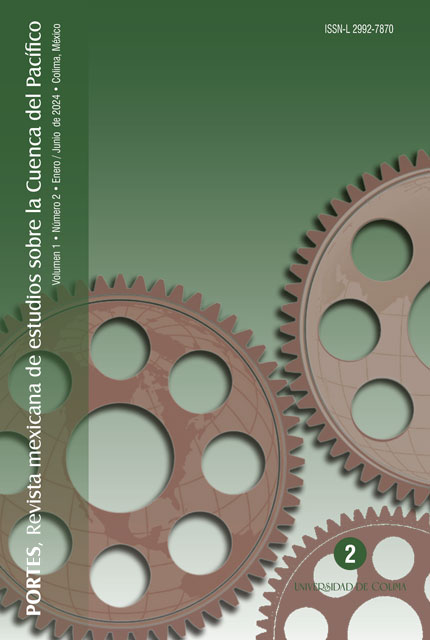The historical construction of Japanese national identity
DOI:
https://doi.org/10.53897/RevPortes.2024.02.07Keywords:
Japan, identity, Constructivism, Hua-Yi distinction, HistoryAbstract
Using the relational identity perspective of critical constructivism, it is proposed that Japan's national identity (i.e., the official narrative represented in Nihonjinron) has been a political construction made by decision-making leaders, and has been established on selectively replicating foreign entities, with the aim of providing order and legitimation to the authorities while pursuing a nationalist narrative. In the Edo period with China, in the imperial phase with the West, and in the post-war era with the United States; It is observed that there continually exists a “teacher” o center (Hua) who exerts great influence over the country, and that Japanese leaders seek to selectively replicate, while maintaining a particular notion of identity. The great temporal extension of the research is defended, arguing the nature of the objective as well as the importance of a broad and different view other than modern State-centrism in International Relations.
Downloads
Metrics
References
Acharya, A. & Buzan, B. (2017). Why is there no Non-Western International Relations Theory? Ten years on. International Relations of the Asia-Pacific, 17, 341–370. doi: 10.1093/irap/lcx006
Auslin, M. R. (2000). Negotiating with imperialism: Japan and the unequal treaty regime, 1858–1872. [Tesis de doctorado, University of Illinois at Urbana-Champaign]. ProQuest One Academic.
Burcu, O. (2022). The Chinese government’s management of anti-Japan nationalism during Hu-Wen era. International Relations of the Asia-Pacific, 22(2). Pp. 237-266.
Calduch Cervera, R. (2014). Métodos y técnicas de investigación internacional (2da edición). Madrid: Universidad Complutense de Madrid (Edición electrónica original: 1998).
Chiavacci, D. (2008). From Class Struggle to General Middle-Class Society to Divided Society: Societal Models of Inequality in Postwar Japan. Social Science Japan Journal, 11(1), 5–27.
Ebrey, P., Walthall, A. & Palais, J. (2009). Modern East Asia: a cultural, social and political history. Boston: Houghton Mifflin Company.
Forbush, E. & Toyosaki, S. (2017). Japan's Internationalization: Dialectics of Orientalism and Hybridism. En Forbush (Ed.) Intercultural Communication in Japan: Theorizing Homogenizing Discourse (pp.129-142). Routledge.
González-Pujol, I. (2022). Contradicciones y cambio en la política exterior japonesa del siglo XXI: Una mirada teóricoanalítica a la estrategia hedging de Japón. Mirai. Estudios Japoneses, 6. Pp. 11-24.
Griffiths, M. (2001). Fifty key thinkers in International Relations (2da edición). Taylor & Francis e-Library. (Edición original: 1999).
Hagström, L., & Gustafsson, K. (2015). Japan and identity change: why it matters in international relations. The pacific review, 28(1). 1-22.
Hall, J.W. (1974). Rule by Status in Tokugawa Japan. Journal of Japanese Studies, 1(1), 39-49. doi:10.2307/133436
Hall, J. W. (1991). The Bakuhan system (pp. 128-182). En J. McClain & J. Hall (Eds.), The Cambridge History of Japan. Cambridge: Cambridge University Press. doi:10.1017/CHOL9780521223553.005
Howell, D. L. (1998). Territoriality and Collective Identity in Tokugawa Japan. Daedalus, 127(3), 105-132. https://www.jstor.org/stable/20027509
Inoguchi, T. (2007). Are there any theories of international relations in Japan? International Relations of the Asia-Pacific, 7, 369–390. doi:10.1093/irap/lcm015
Instituto de Tecnología de Massachusetts (2012). Tokyo 1960: Days of Rage & Grief. https://visualizingcultures.mit.edu/tokyo_1960/anp2_essay01.html
Jordan, C. (2019). Postnormal Japan. En Z. Sardar (Ed.) The Postnormal Times Reader (pp. 252-260). International Institute of Islamic Thought.
Kang, D. C. (2010). Hierarchy and Legitimacy in International Systems: The Tribute System in Early Modern East Asia. Security Studies, 19(4), 591 622. doi:10.1080/09636412.2010.524079
Kasulis, T. (2018). Engaging Japanese philosophy: a short story. University of Hawai‘i Press.
Kitagawa, J. M. (1987). On understanding Japanese religion. Princeton University Press.
Koga, K. & Katada, S. (2023). The enduring dilemma of Japan’s uniqueness narratives. En D. Deudney, J. Ikenberry & K. Postel-Vinay (Eds.), Debating Worlds Contested Narratives of Global Modernity (pp. 115-142). Oxford University Press.
Kohno, M. (2014). East Asia and international relations theory. International Relations of the Asia-Pacific, 14(1). 179-190. https://doi.org/10.1093/irap/lct024
Koyama, H., & Buzan, B. (2018). Rethinking Japan in mainstream international relations. International Relations of the Asia-Pacific, 0. 1-28. doi:10.1093/irap/lcy013
Lindgren, W. Y. (2021). Japanese foreign policy repertoires: Contests, promotions and practices of legitimation. [Tesis doctoral, Universidad de Estocolmo].
Matsubara, H. (1969). The Family and Japanese Society After World War II. The Developing Economies, 7(4). Pp. 499-526.
Maya-Ambía, C. (2021). Japón: el cansancio de una nación. Universidad Nacional Autónoma de México.
Picken, S. (2011). Historical dictionary of Shinto (2da edición). Scarecrow Press, Inc. (Edición original: 2002).
Ringmar, E. (2019). A history of international relations: a non-European perspective. Open Book Publishers.
Ruggie, J. (1998). “What makes the world hang together? Neo-utilitarianism and the social constructivist challenge”. International Organization, 52(4). Pp. 855-885.
Spruyt, H. (2020). The world imagined: collective beliefs and political order in the Sinocentric, Islamic and Southeast Asian international societies. Cambridge University Press.
Stewart, D. (2020). China’s Influence in Japan. Center for Strategic & International Studies. Acceso digital por JSTOR: https://www.jstor.org/stable/resrep25323.5
Sugimoto, Y. (2014). An introduction to Japanese society (4ta edición). Cambridge University Press (Edición original: 1997).
Sun, G. (2007). How does Asia mean? En K. Chen & B. Chua (Eds.), The Inter-Asia Cultural Studies Reader. Routledge.
Tamamoto, M. (2003). Ambiguous Japan: Japanese national identity at century’s end. En John Ikenberry & Michael Mastanduno (Eds), International Relations Theory and the Asia-Pacific (pp. 191-212). Columbia University Press.
Wang, H. (2007). The politics of imagining Asia: a genealogical analysis. En K. Chen & B. Chua (Eds.), The Inter-Asia Cultural Studies Reader. Routledge.
Weber, C. (2005). International relations theory: a critical introduction. (2da edición). Routledge (Edición original: 2001).
Wendt, A. (1992). Anarchy is what states make out of it: the social construction of power politics. International Organization, 46(2). Pp. 391-425.
Williams, A., Hadfield, A. & Simon Rofe, J. (2012). International History and International Relations. Routledge.
Wolff, D. S. (2003). Notes from the periphery: Satsuma identities in early modern and modern Japan. [Tesis de doctorado, Universidad de Chicago]. ProQuest One Academic.
Yahuda, M. (2019). The International Politics of the Asia Pacific (4ta edición). Routledge. (1ra edición: 1996).
Downloads
Published
How to Cite
Issue
Section
License
Copyright (c) 2024 University of Colima

This work is licensed under a Creative Commons Attribution-NonCommercial-ShareAlike 4.0 International License.
La revista PORTES de la Universidad de Colima se distribuye bajo una Licencia Creative Commons Atribución-NoComercial-CompartirIgual 4.0 Internacional





